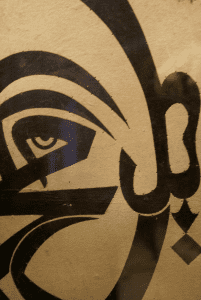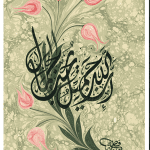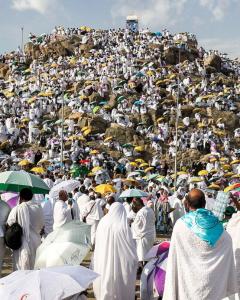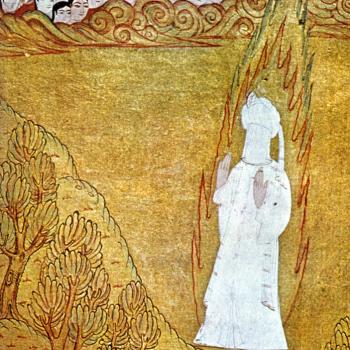
There are so many manifestations of beauty in life. This has always been for me the supreme evidence of God, an indication that all of existence proceeds from a divine Source. And so, when I first heard the Hadith Qudsi, “God is beautiful and loves the beautiful,” I thought: this makes deep sense. Could it be that Beauty is a path to God?
Then one day my teacher said to me, “Beauty is our point of contact with Love.” I sensed that there was a lot behind this assertion, that he was describing a precise metaphysical equation. “Beauty has been created for a purpose. It touches us and awakens something in our own faculties. We respond with love.”
I always loved a traditional Sufi saying: The human face is the place of Epiphany (tajalliyah). The human face has the potential of shining forth the Divine. Beauty and love can radiate from the face of the human being. Even though Islam does not encourage representational art in the sacred context, Bektashi Sufis used calligraphy to fashion faces out of words (see the image accompanying this article). Involved as they are in the mysticism of letters and words, it was quite natural for them to see the handwriting of God in the features of the human face.
In the 18th century there was a great Mevlevi poet, Galip Dede, who wrote an important epic poem, Beauty and Love[1]. In this allegory of the dervish path, Love (the dervish) must face many challenges in order to be worthy to win the hand of Beauty. The Lover must purify his heart, show his courage, be willing, if necessary, to die for the Beloved. The Lover must experience the “voluntary death” referred to in the hadith “Die before you die.”
In Galip’s poem, Love must recognize and ultimately destroy an illusory Chinese princess’s “Fortress of Forms,” representing all the temptations of material existence that waylay the lover. Only then can he begin to journey in the Land of the Heart where Beauty resides.
The Land of the Heart is where “the arc of ascent,” the journey of spiritual imagination, begins. It is Imagination that makes this possible by awakening the reality of Love and Beauty in the Lover.
A brief lesson in metaphysics
Existence is the realm of “forms,” and forms do not spring forth on their own from material existence; rather, they are brought down to earth from the realm of spiritual qualities and archetypes. As it is said: “Everything in existence is the manifestation of the single source of life and being.” They are embodied meanings. As such, they can also lead back to their source.
This process of manifestation and embodiment is called in Sufism the “arc of descent.” Following the arc of descent, each individual life is thrown into the experience of separation, and the human lover yearns for the Beloved, Beauty. The possibility of return, “the arc of ascent,” awakens with a yearning for something beyond material existence. Like the reed torn from the reed bed, each soul longs to return to its Origin. This is the traditional metaphysics that is found both in Sufism and also in the metaphysical traditions of the West, tracing all the way back to the Pythagoreans and the Greek mystery religions.
Among Sufis like Attar, Ibn Arabi, and Rumi, the return journey is with and through the faculty of spiritual imagination. The metaphors and stories of the poetic imagination and divine revelation can motivate, inspire, and guide the seeker.
The Quran, for instance, is more than a book of laws and prescriptions; it is a visionary landscape that awakens the spiritual imagination. The Quran describes a reality in which faith meets with denial, in which consciousness contends with heedlessness, in which prophets bring the message of overwhelming Divine Mercy and Love. This revelation is calling us to awaken to spiritual reality through the instrument of the heart, and to be able to read the Book of Life with our higher faculties.
Attar’s Conference of the Birds, for instance, is another great epic allegory of the spiritual journey. And we know how Rumi can capture the most sublime and subtle spiritual realizations in images and metaphors a child could appreciate. And Ibn Arabi, whose metaphysical and scriptural insights fill so many volumes, could describe his own state in this short poem:
Glory be to God, a garden within the flames!
My heart has become capable of all forms.
It is a temple for idol worshipers;
a monastery for monks;
a Kaabah for pilgrims,
the tablets of the Torah, the Book of the Quran.
It is a pasture for gazelles.
I follow the religion of Love
and where ever its caravan turns,
I follow.
When the spiritual imagination awakens, the world is transformed. It is the same world, but seen differently. The seeker is guided by spiritual imagination through a landscape of meaning and beauty, to the Land of the Heart, where Beauty ultimately resides. Only the purified heart of the Lover can be worthy of wooing and wedding this Beauty. These few words cannot convey the immensity of this journey; it is more like the six volumes of Rumi’s Mathnawi; it is the journey of the seeker’s life with no shortcuts.
But eventually, we are told, the Lover experiences that this Beauty, which has been the magnetic attractor all along, which was the cause of all this seeking, has been with him/her from the very beginning. Or as Rumi expresses it in a ghazal:
The funny part is
that in this search,
Beauty has always accompanied you.
Wherever you have been,
She is the One holding your hand.
Keep looking for Her with Her;
You and She are on the same road.
O Beloved, You’re so obvious
You’re hidden from sight![2]
And what is there beyond this, now that the seeking has reached its fulfillment? It is now that the human being, aware of being loved in this cosmic sense, can begin to more fully reflect Beauty in the mirror of action, in the world of manifest forms. The idea of reflecting beauty in the mirror of action takes us further than just being a passive witness of beauty. It is advising us to internalize beauty and, in turn, lovingly express beauty in action.
I have experienced exceptional beauty in many spiritual lineages. And I can say that within the Mevlevi tradition of Rumi, beauty is developed as a way of life. There is beauty in its art, music, literature, food, and architecture. This art of extraordinary beauty especially comes alive in conscious community. The spiritual education of Sufism is made possible more through “community” than through “tutorial.” The ideal Sufi community is imbued with a vibration of beauty and love. Love is a seeker of Beauty; and Beauty is our point of contact with Love.
[1] Beauty and Love, Seyh Galip, translated by Victoria Rowe Holbrook, MLA, New York, 2005.
[2] The Pocket Rumi, Translated by Helminski. Shambhala Pocket Classics. Boulder, 2008.












